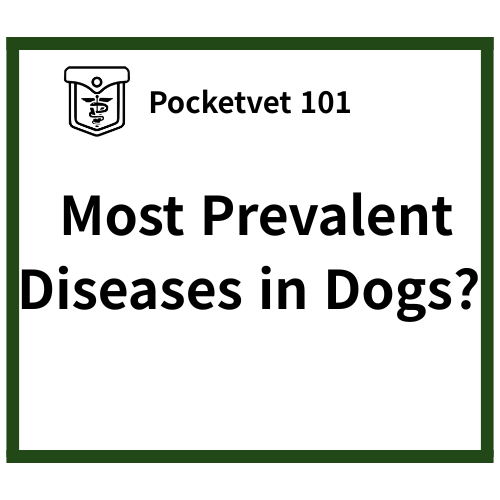
Most Prevalent Disorders in Dogs Under Primary Veterinary Care 🐶📋
Dogs are a beloved companion across the UK, with 26% of the adult population owning at least one dog and an estimated 9.9 million dogs in total. While dog ownership brings numerous benefits to humans and their furry friends, it also comes with the responsibility of managing their health. A recent study using data from the VetCompass™ Programme sheds light on the most common health disorders affecting dogs under primary veterinary care in the UK.
This study, conducted in 2016, analyzed a random sample of 22,333 dogs from a population of 905,543 dogs treated at 886 veterinary clinics. It aimed to identify the prevalence of common disorders in dogs and explore the influence of age, sex, and neuter status. The findings provide valuable insights for veterinarians, breeders, and owners to prioritize health interventions and preventive care.
Leading Disorders in Dogs: Key Findings 🩺🐾
1. Prevalence of Disorders
Out of the 22,333 dogs analyzed, 65.84% (14,704 dogs) had at least one disorder recorded during 2016. The remaining 34.16% of dogs were either only presented for preventive care (e.g., vaccinations) or did not visit the clinic for that year. Dogs with at least one disorder had a median age of 5.15 years, while dogs without any recorded disorders had a younger median age of 3.33 years.
The study categorized disorders into two levels:
- Precise-level precision: Disorders recorded with the highest diagnostic certainty.
- Grouped-level precision: Disorders grouped into broader diagnostic categories.
2. Most Prevalent Disorders (Precise-Level)
At a precise diagnostic level, the most common disorders recorded in dogs were as follows:
| Disorder | Number of Cases | Prevalence (%) | Median Age (Years) |
|---|---|---|---|
| Periodontal Disease | 2,797 | 12.52 | 7.54 |
| Otitis Externa | 1,631 | 7.30 | 4.72 |
| Obesity | 1,580 | 7.07 | 5.99 |
| Overgrown Nails | 1,233 | 5.52 | 4.68 |
| Anal Sac Impaction | 1,071 | 4.80 | 5.24 |
1) Periodontal Disease
Prevalence: 12.52%
Periodontal disease was the most common disorder, particularly affecting older dogs with a median age of 7.54 years. Neutered dogs were slightly more likely to develop it compared to entire dogs. This highlights the importance of regular dental care for dogs, especially as they age.
2) Otitis Externa
Prevalence: 7.30%
This ear disorder was common among younger dogs, with a median age of 4.72 years. Male dogs showed higher odds of developing otitis externa compared to females. Proper ear cleaning and management of allergies could help reduce its occurrence.
3) Obesity
Prevalence: 7.07%
Obesity was more prevalent in neutered dogs, likely due to changes in metabolism post-neutering. The median age of affected dogs was 5.99 years. Obesity is a growing concern as it increases the risk of secondary conditions like osteoarthritis and diabetes.
4) Overgrown Nails
Prevalence: 5.52%
Overgrown nails, often the result of insufficient claw trimming, were common in dogs with a median age of 4.68 years. Routine grooming and nail maintenance are essential in preventing this issue.
5) Anal Sac Impaction
Prevalence: 4.80%
This condition, linked to discomfort and scooting behavior in dogs, was common among middle-aged dogs. Regular anal gland checks during veterinary visits can help mitigate this issue.
3. Most Prevalent Disorders (Grouped-Level)
When disorders were grouped into broader categories, the findings showed slightly different trends. The most common grouped-level disorders were:
| Grouped Disorder | Number of Cases | Prevalence (%) | Median Age (Years) |
|---|---|---|---|
| Dental Disorders | 3,148 | 14.10 | 7.12 |
| Skin Disorders | 2,810 | 12.58 | 5.00 |
| Enteropathy (GI issues) | 2,330 | 10.43 | 3.42 |
| Musculoskeletal Disorders | 1,929 | 8.64 | 7.53 |
| Ear Disorders | 1,825 | 8.17 | 4.82 |
1) Dental Disorders
Prevalence: 14.10%
Dental issues, including periodontal disease, were the most common grouped condition. These findings emphasize the need for routine dental care, such as brushing teeth and professional cleanings.
2) Skin Disorders
Prevalence: 12.58%
Skin issues such as dermatitis and pruritus were highly prevalent. These disorders often stem from allergies, parasites, or infections, highlighting the importance of proper hygiene and parasite prevention.
3) Enteropathy (Gastrointestinal Issues)
Prevalence: 10.43%
Gastrointestinal disorders, including diarrhea and vomiting, were common in younger dogs (median age: 3.42 years). These conditions may be due to dietary indiscretion, infections, or food sensitivities.
4) Musculoskeletal Disorders
Prevalence: 8.64%
Disorders such as lameness and osteoarthritis were frequently observed in older dogs, with a median age of 7.53 years. Maintaining a healthy weight and providing joint supplements can help manage these conditions.
5) Ear Disorders
Prevalence: 8.17%
Ear infections and related conditions were more common in younger dogs. Regular ear cleaning and monitoring can help prevent complications.
Influence of Demographics on Disorder Prevalence 📊
1. Age
Older dogs were more likely to have at least one recorded disorder. Disorders such as periodontal disease, osteoarthritis, and heart murmurs predominantly affected dogs aged over 7 years. Younger dogs were more prone to infectious diseases, diarrhea, and vomiting.
2. Sex
Male dogs had higher odds of developing certain disorders like otitis externa, aggression, and musculoskeletal injuries. Female dogs were more likely to suffer from urinary incontinence, urinary tract infections, and claw/nail disorders.
3. Neuter Status
Neutered dogs had higher odds of developing obesity, periodontal disease, and urinary incontinence. Entire (non-neutered) dogs were more likely to present with reproductive system disorders and parasite infestations.
Practical Applications of the Findings 🐕💡
The study’s findings provide actionable insights for improving canine health:
- Preventive Care: Encourage regular dental cleanings, weight management, and grooming to reduce the prevalence of common disorders.
- Targeted Interventions: Tailor health strategies based on age, sex, and neuter status to address the specific needs of different demographic groups.
- Owner Education: Raise awareness among dog owners about the importance of preventive care and early detection of health issues.
- Veterinary Focus: Equip veterinarians with data-driven insights to prioritize common disorders in their clinical practice.
Conclusion 🐾
The study highlights the most prevalent disorders in UK dogs under primary veterinary care, with periodontal disease, otitis externa, and obesity topping the list. These findings underscore the importance of proactive health measures, such as routine check-ups and preventive care, to improve the overall well-being of dogs. By leveraging this data, veterinarians and owners can better address the health challenges faced by dogs and ensure a higher quality of life for our furry companions.

Leave a Reply